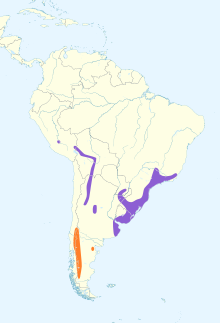| Hellmayr's pipit | |
|---|---|

| |
| Conservation status | |
 Least Concern (IUCN 3.1) | |
| Scientific classification | |
| Domain: | Eukaryota |
| Kingdom: | Animalia |
| Phylum: | Chordata |
| Class: | Aves |
| Order: | Passeriformes |
| Family: | Motacillidae |
| Genus: | Anthus |
| Species: | A. hellmayri |
| Binomial name | |
| Anthus hellmayri Hartert, 1909 | |

| |
Hellmayr's pipit (Anthus hellmayri) is a species of bird in the family Motacillidae. It is found in Argentina, Bolivia, Brazil, Chile, Paraguay, Peru, and Uruguay. Its natural habitats are temperate grassland, subtropical or tropical high-altitude grassland, and pastureland.
Taxonomy
Hellmayr's pipit was described by Ernst Hartert in 1909 who placed it in the genus Anthus. The bird is named after Austrian ornithologist, Carl Eduard Hellmayr. There are currently three recognized subspecies:
- A. h. hellmayri - (Hartert, 1909): south Peruvian Andes, Bolivia, and the Tucumán rainforest in Argentina
- A. h. dabbenei - (Hellmayr, 1921): Andes of western Argentina and adjacent parts of Chile
- A. h. brasilianus - (Hellmayr, 1921): Brazil south of Minas Gerais into Uruguay and Buenos Aires Province, Argentina, across Corrientes and Entre Ríos provinces into southern Paraguay
Description
Hellmayr's pipit is a medium-sized brown bird weighing 18.6g. It has pink legs and a light pink bill. Its back is boldly streaked and its breast and flanks are only faintly streaked. It can be confused with the similar-looking Short-billed pipit but its throat is white instead of streaked and it lacks the white submoustachial stripe. Eggs are oval in shape and white with brown speckles.
Distribution
Hellmayr's pipit is found in three disjunct populations across the southern half of South America. It is found in the Andes from southern Peru, through Bolivia into northwestern Argentina, as well as in the Andes of southern Argentina and Chile. The eastern population (A. h. brasilianus) ranges from Espinhaço Range in the Brazilian states of Minas Gerais and Bahia, south down into Uruguay and eastern Argentina, and west into the chaco of Paraguay. It occurs from sea level to 3,700 meters.
Behaviour
It is year round in most of its range, with its breeding season being in the rainy season from September to April. Males are known to perform aerial displays for females during breeding season. The population in Chile and southern Argentina (A. h. dabbenei) is known to be migratory. They are mainly insectivores. Nests are cup-shaped with a grass dome built over top of it being roofed with dry stems. Nests are built on the ground in grass mounds. They have a maximum clutch size of five eggs. Both parents participate in the feeding of the fledglings.
References
- BirdLife International (2018). "Anthus hellmayri". IUCN Red List of Threatened Species. 2018: e.T22718597A131989841. doi:10.2305/IUCN.UK.2018-2.RLTS.T22718597A131989841.en. Retrieved 12 November 2021.
- Hartert, 1909. Anthus hellmayri (protonym). Novitates Zoologicae, 16, p. 165. BHL
- "Hellmayr's pipit". Avibase. Retrieved 10 May 2024.
- Lowen, James C.; Clay, Robert P.; Barnett, Juan Mazar; N., Alberto Madroño; Pearman, Mark; Lanús, Bernabé López; Tobias, Joe A.; Liley, Durwyn C.; Brooks, Thomas M.; Esquivel, Estela Z.; Reid, Jane M. (1997). "New and noteworthy observations on the Paraguayan avifauna". Bulletin of the British Ornithologists' Club. 117 (4): 278. Retrieved 10 May 2024.
- ^ Rivas, Francisco; Norambuena, Heraldo V.; Grandón Díaz, Catalina; Seitz, Sophie N.; Peña Bello, Esteban (4 December 2023). "Description of the eggs and nest, with notes on the breeding ecology of Hellmayr's Pipit Anthus hellmayri dabbenei in Chile". Bulletin of the British Ornithologists' Club. 143 (4). doi:10.25226/bboc.v143i4.2023.a5. Retrieved 10 May 2024.
- ^ Ferreira de Vasconcelos, Marcelo; Esteves Lopes, Leonardo (October 2011). "On the wide occurrence of the Hellmayr's pipit Anthus hellmayri in the espinhaço range, Southeastern Brazil, with comments on its natural history". Interciencia. 36 (10). Retrieved 10 May 2024.